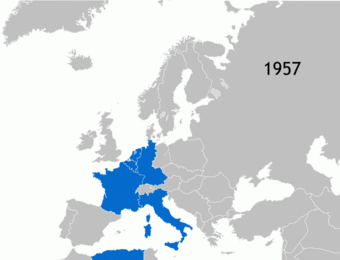Ohlin Report
Part of a series on the |
||||||||||||||||||||||||
|---|---|---|---|---|---|---|---|---|---|---|---|---|---|---|---|---|---|---|---|---|---|---|---|---|
| History of the European Union |
||||||||||||||||||||||||
 | ||||||||||||||||||||||||
|
Organisation
|
||||||||||||||||||||||||
|
||||||||||||||||||||||||
|
| ||||||||||||||||||||||||
The Ohlin Report was a report drafted by a group of experts of the International Labour Organization led by Bertil Ohlin in 1956. Together with the Spaak Report it provided the basis for the Treaty of Rome on the common market in 1957 and the creation of the European Economic Community in 1958.
Summary
The key element of the Olin Report was that the Common Market did not presuppose a harmonised level of labour standards. The report explained that exchange rates between countries reflect economic productivity and, thereby, offset the advantages of lower wages in other States. As a consequence, States with a higher levels of social protection and higher wages should not fear competition from low cost countries. This explains the fact that the Articles 117 and 118 of the European Economic Community treaty are soft in nature, while in contrast the hard Articles 119 and 120 of the EEC treaty have a limited scope.[1][2]
See also
Notes
- ↑ Fuchs, Maximilian (22 June 2004). "The bottom line of European Labour Law (Part I)". International Journal of Comparative Labour Law and Industrial Relations.
- ↑ Rogowski, Ralf; Kajtár, Edit (25–26 November 2004). "The European Social Model and Coordination of Social Policy" (PDF). Managing Social Risks through Transitional Labour Markets.
References
- International Labour Organisation, Social Aspects of European Economic Co-operation. Report by a Group of Experts (summary), in: (1956) 74 International Labour Review, at 99-123.
- André Sapir, The Interaction Between Labour Standards and International Trade Policy, The World Economy 18 (6), 791–803.
- J. Kenner, EU Employment Law: From Rome to Amsterdam and Beyond, Oxford: Hart Publishing, 2003, 593pp